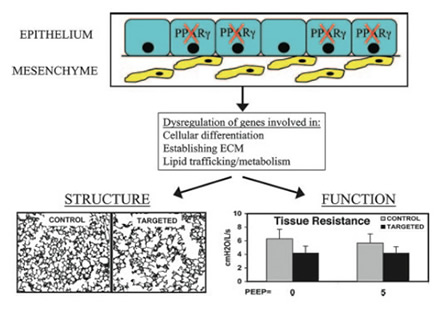The Role of Airway Epithelial Cell PPARg in Lung Maturation and Maintenance

A greater appreciation of novel pathways contributing to normal lung maturation and maintenance are needed in an effort to understand both the mechanisms leading to COPD and other chronic lung diseases, as well as targets for therapeutic intervention. Peroxisome proliferator-activating receptor (PPAR)-g is a regulator of cellular differentiation, organ development and tissue homeostasis/inflammation. PPARg is expressed in numerous cell types within the lung and is prominent particularly within airway epithelial cells. In an effort to study the physiological role of PPARg within these cells, we have generated a novel line of mice that are deficient in airway epithelial cell-specific PPARg using a conditional gene targeting approach. We have shown that deficiency in PPARg specifically within airway epithelial cells leads to a defect in lung maturation and subsequent developmental emphysema-like phenotype. This is due, at least in part, to an alteration in conducting airway epithelial cell differentiation, uncoupling of normal epithelial-mesenchymal cell interactions necessary for proper lung development, and subsequent insufficiency in extracellular matrix (ECM) production. Further, we observe that mice deficient in airway epithelial cell PPARg show increased susceptibility to the development of emphysema in response to chronic cigarette smoke exposure. Accompanying the increased susceptibility to emphysema in these animals was an amplified inflammatory response, as evidenced by an increased number of tissue macrophages. Our preliminary data identifies epithelial cell PPARg as a modulator of lung maturation and maintenance, and further implicates PPARg as a potential genetic susceptibility factor for the development of COPD. We propose that airway epithelial cell PPARg is necessary for normal lung maturation and maintenance by; 1) promoting proper epithelial-mesenchymal interactions necessary for the integrity of distal lung ECM and lung structure/function and 2) limiting epithelial cytokine networking during inflammation.